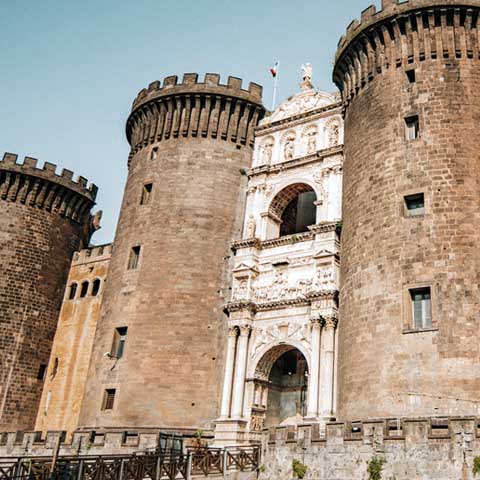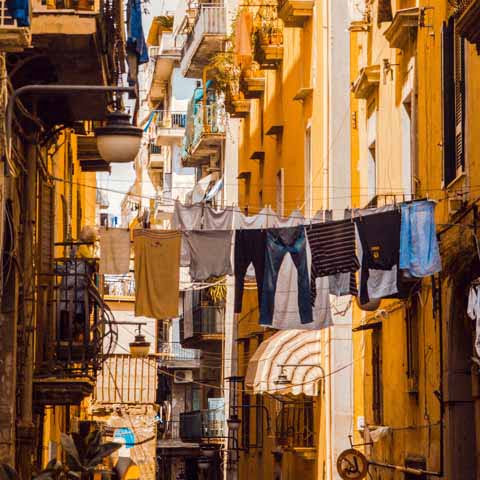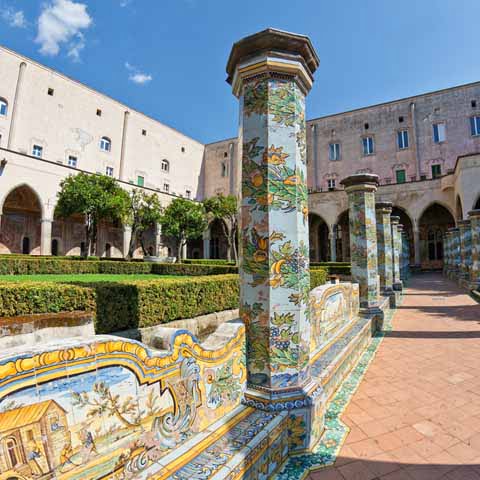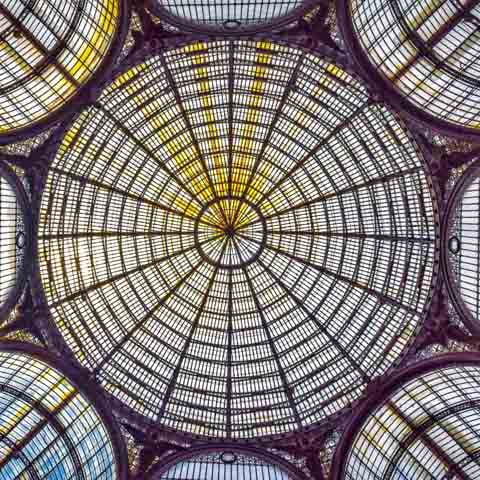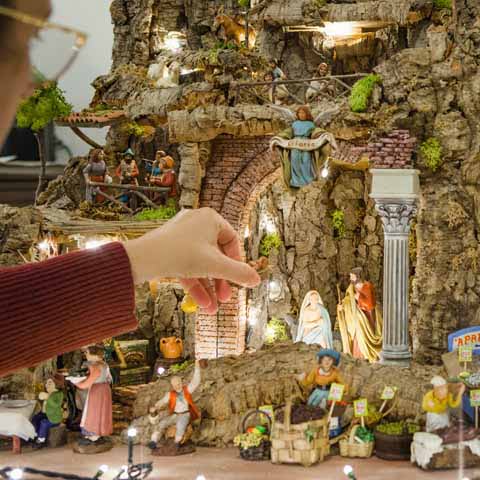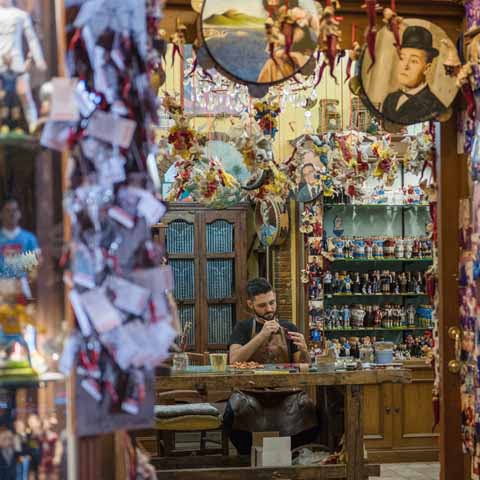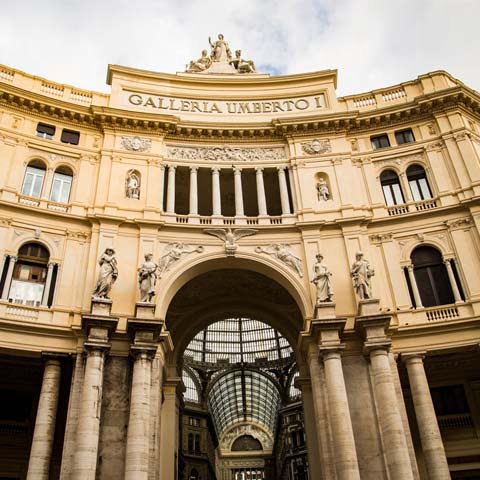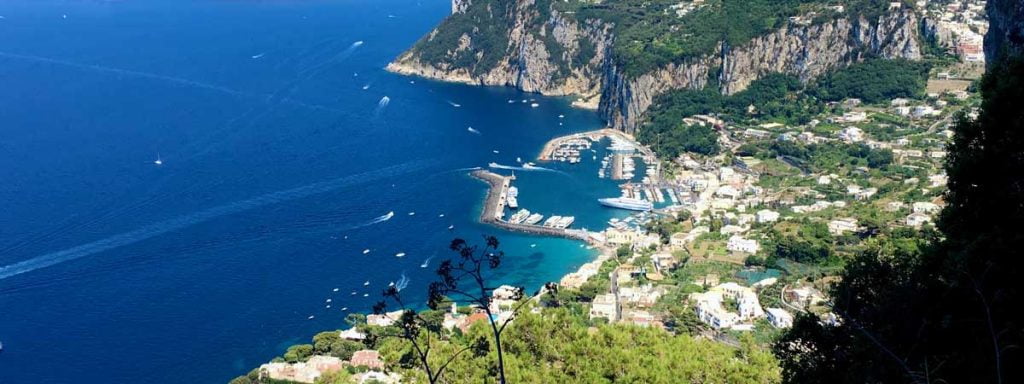The thriving port city of Naples served as the capital of the powerful Kingdom of Naples for centuries, amassing a remarkable amount of art and other treasures, making the city what it is today. While traveling through Naples, visitors will be mesmerized by the architecture of striking castles and churches and many different forms of art including paintings, frescoes, and music. Plan to spend at least a few days here to thoroughly enjoy all that Naples has to offer.
To truly understand the culture of Naples, one must learn about the city’s devotion to patron saint San Gennaro (or Saint Januarius). During the first half of the sixteenth century, the city was devastated by multiple tragedies including the plague, several eruptions of Mount Vesuvius, and war between the Spanish and the French. In response, the people of Naples vowed that if San Gennaro would protect the city, they would build a new chapel in Naples’ Cathedral dedicated to the saint that would hold San Gennaro’s relics and treasure. San Gennaro accepted the vow and interceded on the city’s behalf by stopping the plague, while the citizens of Naples upheld their end and created the beautiful Chapel of San Gennaro with marble sculptures, silver, and stunning art. Many remarkable masterpieces were commissioned and would become part of the treasure of San Gennaro, which also features vials of the saint’s blood, and is still housed in the chapel to this day.
San Gennaro is considered to be the special protector of the Neapolitan people and a symbol of hope. Each year, there are three days in which the holy blood of San Gennaro is displayed in the Chapel of San Gennaro: September 19 (The Feast of San Gennaro), December 16, and the first Saturday of May. On these days, the locals pray to San Gennaro and the saint’s blood is said to liquefy. These miracles, celebrated by everyone in the city, represent the saint’s continued protection of Naples. Over the years, there have been only a few times when the blood has not liquified, and when this occurs it is viewed as a bad omen for the year. The most notable example was in September 1980, when the blood did not liquify and the Irpinia earthquake devasted the Campania region two months later. Truly, the devotion of Neapolitans to their patron saint is unlike any other in Italy, and though he died at the beginning of the fourth century AD, San Gennaro is still an integral part of Neapolitan culture.
ARCHITECTURE IN NAPLES ITALY
With the rich history of the city of Naples, it is not surprising that architecture styles are varied with Medieval, Renaissance, and Baroque influences.
The historic city center of Naples is the largest in Europe offering plenty of opportunities to admire countless examples of stunning architecture. The main road that crosses the city center is known as Spaccanapoli, and many of the city’s most important monuments and churches are located either along Spaccanapoli or near this main road. Spanning approximately one mile, Spaccanapoli runs east to west and was part of the original layout of the ancient city. Today, Spaccanapoli is composed of several important streets including Via Benedetto Croce and Via San Biagio dei Librai, and it also intersects with Via Duomo. A walk down Spaccanapoli is the perfect way to start exploring the city center.
One of the many sights travelers can admire along Spaccanapoli is the Naples Cathedral or Cattedrale di San Gennaro. This is the most well-known church in the area due to the city’s celebration of the patron saint, San Gennaro, which takes place there each September. Construction of the church was completed after several decades during the early fourteenth century under the House of Anjou. In 1456, an earthquake caused major damage to the cathedral, though it was subsequently rebuilt and renovated during the following years. The current façade, with a Neo-Gothic style, is actually fairly recent and dates back to 1905. The interior of the church is marked with tall, grand archways, a gilded ceiling, and a number of frescoes. In particular, be sure not to miss the frescoes of the Royal Chapel of the Treasure of San Gennaro. The chapel holds a bust with the skull of San Gennaro and two containers of the saint’s blood. Further relics of the saint can be found in an adjacent chapel as well as the Carafa Chapel.
Across from the Cathedral, travelers can visit the Church and Convent of the Girolamini. The façade dates back to the eighteenth century and was designed in a Late Baroque style by Ferdinando Fuga. The adjacent convent consists of two cloisters as well as a modest art gallery featuring works by local Neapolitan artists that range from the sixteenth to the eighteenth centuries. Inside the complex, visitors can admire frescoes by Francesco Solimena as well as stunning angel sculptures by Giuseppe Sanmartino, who is best known for his sculpture Veiled Christ held in the Chapel of San Severo. Also on the grounds of the church and convent is the Girolamini Library, which is the oldest in the city of Naples and the second oldest in the country.
The Church of Santa Chiara is part of a larger religious complex that also includes an archaeological museum, monastery, and tombs. This early fourteenth century structure was built under King Robert of Naples. The building was partially destroyed during the bombings of World War II but has been restored over time. The church is rectangular with a single nave and nine chapels on each side. The complex’s museum offers a lovely history of the church as well as some artifacts recovered from the church after the bombing. Also of note is the remarkable Cloister of the Poor Clares, which is decorated with beautiful majolica tiles and frescoes.
One of the more ancient churches in Naples is the Basilica of San Paolo Maggiore. Though it was reconstructed at the end of the sixteenth century, the original structure dates back to the eighth century. Featuring a beautiful Baroque façade, the church is highly revered for its interior which houses gold stucco decorations, art by Massimo Stanzione and Paolo de Matteis, and a remarkable floor composed of geometric shapes, which is the work of Nicola Tammaro. Also highly esteemed are the eighteenth-century frescoes by Francesco Solimena and Domenico Antonio Vaccaro. Unfortunately, the church was damaged by Allied bombing during World War II and the frescoes by Massimo Stanzione suffered severe damage.
Another remarkable church is the Basilica of San Lorenzo Maggiore, which, interestingly, is located at the very center of Naples’ historic city center. The church is actually a complex that includes a monastery. Considered to be one of the most remarkable medieval buildings in Naples, the church features a striking façade by Ferdinando Sanfelice as well as two chapels decorated in the Baroque style. In fact, at one time the majority of the church, including the façade, featured a Baroque style, though these additions have since been removed in order to reveal the church’s original Gothic characteristics. The church was influential in the lives of two important Italian writers; Petrarch is said to have lived in the church’s convent for a time, and it is believed that Bocaccio met Mary of Anjou, who inspired the character of Fiammetta in Decameron, at this church. Underneath the church, it is possible to admire Greek and Roman ruins.
The Dominican Church of San Domenico Maggiore dates back to the early fourteenth century, though certain elements were added later, such as the spire, which was completed in the eighteenth century. The church and convent originally hosted the University of Naples. Today the church features Gothic and Baroque elements, and it is the site of the several tombs of the Aragonese royal family.
Watching over the city of Naples on the Vomero Hill is the Certosa di San Martino. Once a Carthusian monastery complex, the hilltop position of this site ensures that it and the adjacent Castel Sant’Elmo are visible no matter where you are in Naples. The complex was completed in 1368 and underwent expansions during the sixteenth and seventeenth centuries. Of particular note are the cloisters and Baroque sculptures by Giovanni Antonio Dosio. Today the structure is home to the National Museum of San Martino where exhibits featuring Spanish and Bourbon artifacts and historic nativity scenes (for which Naples is world-renowned) can be admired.
One of the most remarkable fountains in the city is the Fontana del Nettuno. The work of several artists including Domenico Fontana, Michelangelo Naccherino, and Pietro Bernini, this beautiful marble fountain was constructed in 1600. Over the centuries, it has been moved to various locations within Naples’s city center. Richly decorated with a balustrade, marble lions, sea monsters, shells, and, of course, Neptune, today the fountain is located in Piazza Municipio.
Piazza del Plebiscito is the largest square in Naples and a true architectural marvel. Constructed using volcanic rock from Mount Vesuvius, the square was completed in the nineteenth century and it celebrates Naples joining the unified Kingdom of Italy. The square and its impressive colonnades have become an iconic symbol of Naples. Occasionally, open-air concerts have been held in the spacious city square. In the center is the Basilica of San Francesco di Paola, which is a copy of Rome’s Pantheon constructed in Neo-Classic style.
Facing Piazza del Plebiscito is Palazzo Reale, or the Royal Palace, which is the most important secular historic building in Naples. Constructed in Baroque and Neo-Classical style, the original structure of the palace dates back to the seventeenth century under the rule of Spanish Viceroy Fernando Ruiz de Castro. Most notably, the palace hosted the House of Bourbon while the dynasty ruled the Kingdom of Naples and the Kingdom of the Two Sicilies from 1735 until the unification of Italy in 1861. The current appearance of the elegant palace is certainly due to the Bourbons, who restored and richly decorated the palace. The façade features statues of important rulers of Naples from the twelfth century onward. The interior features a monumental staircase, a theater, ballroom, historic furniture, and the national library known as Biblioteca Nazionale Vittorio Emanuele III.
The Bourbons had other royal residences in the surroundings of Naples as well. The most notable is the Reggia di Caserta, or Royal Palace of Caserta. In contrast to the Palazzo Reale in Naples, Reggia di Caserta was constructed by the House of Bourbon and was considered to be the main residence of the dynasty. Dating back to the eighteenth century, the palace is the largest royal residence in the world by volume, featuring 1,200 rooms and covering an area of more than 505,000 square feet. The interior of the palace consists of five floors with lavishly decorated halls and rooms, a theater, library, and a Grand Staircase. The surrounding park is just as impressive with a beautiful botanical garden and stunning monumental fountains that depict figures from Greek and Roman mythology.
Another Bourbon palace outside the city center of Naples is the Reggia di Capodimonte, or the Royal Palace of Capodimonte, which was built in the mid-eighteenth century by order of Charles of Bourbon. The rectangular palace features a muted red exterior and is several stories tall. The grounds are well kept and feature several park benches, fountains, and palm trees. Once a holiday residence and hunting grounds for the Bourbons, it is now home to the National Museum of Capodimonte and an art gallery.
Castel Nuovo, also known as Maschio Angioino, is a marvelously charming fairytale castle overlooking the waters of the Tyrrhenian Sea. This thirteenth century castle is one of the first built in the area and is still an architectural landmark of the city. Constructed under Charles I of Anjou, the structure is now the headquarters of the Neapolitan Society of Homeland History and of the Naples Committee of the Institute for the History of the Italian Risorgimento. Serving as a seat for the kings of Naples until 1815, notable people who stayed at the castle include Giovanni Bocaccio, Giotto, and Petrarch. When touring this castle that is still in amazing condition, do not miss the civic museum which includes the Palatine Chapel.
The twelfth century structure of Castel dell’Ovo is a famous seaside castle of Naples located on the former island off Megaride. This ancient castle is largely rectangular and is connected to the mainland by a more than three-hundred-foot-long causeway that is a favorite photography spot for visitors. Just to the side of the castle, underwater archaeologists have recently found what they think are the origins of the first Greek settlement of Paleopolis. The castle’s name, which means Castle of the Egg, refers to a legend that states the Ancient Roman poet Virgil placed an egg underneath the castle. If the egg were to break, it is believed that bad events would occur in Naples.
One of the more unique structures in the area is the Castel Sant’Elmo, located next to the Certosa di San Martino. This castle’s rare six-point star shape makes it quite awe inspiring to behold. The majestic fourteenth century structure was originally a church and eventually a military prison. The castle is surrounded by ramparts and forts and offers truly stunning views of the city and the Tyrrhenian Sea.
In the northern part of Naples, travelers have the opportunity to descend underneath the city and visit the Catacombs of San Gennaro. Divided into two levels, this system of tunnels featuring early Christian burial sites dates back to the third or fourth century.
ART IN NAPLES
Art has been intricately woven into the Neapolitan culture since the city’s founding. Though in contrast to other historic Italian cities at the center of royal kingdoms, such as Palermo, no significant artistic traces from the Greek Roman, Norman, Swabian, or Byzantine periods remain.
The continuous domination of Naples by external powers ensured that a proper local art movement did not appear for quite some time. However, artistic production in Naples was influenced by visits from artists outside of the area, such as Tuscan’s Giotto, Simone Martini, and Giorgio Vasari.
Art inspired by outside influences flowered during the Renaissance. One of the first masterpieces of this period is the tomb of Cardinal Rinaldo Brancaccio, which is located in the fourteenth century Church of Sant’Angelo a Nilo. Naples also hosted the great Sicilian painter Antonello da Messina for a time. In Naples, Messina painted Salvator mundi and Annunciata di Palermo and he also experimented with techniques implemented by Piero della Francesca and Flemish painters such as Jan van Eyck.
During the seventeenth century, Naples was considered to be at the forefront of the Baroque movement thanks to Caravaggio’s arrival in Naples in 1606, and this is when the local art movement is believed to have been born. The earliest local workshops were founded by painters such as Jusepe de Ribera and Massimo Stanzione.
In the eighteenth century, several late-Baroque artists from Naples created remarkable works including Francesco Solimena, Francesco De Mura, and Fedele Fischetti.
After the Baroque period, Neo-Classicism reigned supreme in Naples as local artists were inspired by the newly discovered ruins of Pompeii and Herculaneum.
In the nineteenth century, the local style turned more towards landscape and romantic paintings, following the influences of foreign painters such as William Turner. In fact, the city’s own Accademia di Belle Arti was the center of the artistic School of Posillipo, which was a loose grouping of landscape painters. Several of the most important Neapolitan painters, such as Domenico Morelli, Giacomo Di Chirico, Francesco Saverio Altamura, and Gioacchino Toma, taught at the Academia di Belle Arti. Still today, many of these artists’ works can be found displayed here. Currently, the academy offers instruction on sculpting, painting, design, art restoration, and more.
Italian painter Domenico Morelli was born in Naples, and in the late nineteenth century became staff of the Accademia di Belle Arti. Morelli is best known for painting an Assumption of the Virgin for the ceiling of the Royal Chapel of Naples.
Barber turned sculptor and eventually painter, Giacomo Di Chirico also became a part of the staff at Accademia di Belle Arti. One of Di Chirico’s most renowned painted works is Sposalizio in Basilicata, although he did many paintings before passing away in his late thirties and is considered to be among the best Neapolitan artists of his time.
Francesco Saverio Altamura was a nineteenth century Italian painter who enjoyed painting historic and genre subjects in what is categorized as a romantic style. Altamura was orphaned at a young age, never attended a formal art school, and was primarily self-taught. Among his best works are Madonna morta and Madonna in gloria. These frescoes are displayed in the chapel of Palazzo Reale.
Aside from painting, the art of Capodimonte porcelain is considered uniquely tied to Naples. Charles of Bourbon (later King Charles III of Spain) founded the Royal Factory of Capodimonte in 1743 and the artform flourished. Though the factory was moved to Spain in 1759, the acclaim for Capodimonte porcelain remained, with other local factories adopting the Capodimonte porcelain name in the subsequent years. Some nineteenth century porcelain factories, which operated under the category Naples porcelain, still remain and are active today. To view some of the Capodimonte porcelain and Naples porcelain masterpieces, visit the local National Museum of Capodimonte, located in the Reggia di Capodimonte, where they are displayed.
The National Museum of Capodimonte is considered to be one of Naples’s oldest museums, and it features one of the most important art collections of the city. In addition to the porcelain works, the museum features majolica decorations as well as art from the thirteenth to the eighteenth centuries. The main artists of the Neapolitan school, such as Jusepe de Ribera and Luca Giordano are represented here, as are other great painters including Caravaggio, Raphael, Titian, Giovanni Bellini, and Lorenzo Lotto.
Naples’s other great artform is the creation of nativity scenes, and the historic Neapolitan nativity scene tradition is the most important of its kind. With origins dating back to 1025, local nativity scenes became a true artform during the fifteenth century. Naples’s nativity scenes flourished in the eighteenth century under Charles of Bourbon who brought the tradition to his royal court. The elaborate nativity scenes incorporated local characters and created a snapshot of daily life in Naples at the time. Today the tradition lives on in Neapolitan homes and along Via San Gregorio Armeno, which is where the nativity scene workshops are located and where local artisans continue to craft realistic nativity scene sculptures by hand each year. Historic Neapolitan nativity scenes can be admired at local museums, such as the Reggia di Caserta or the Museum of San Martino. In addition to nativity scenes, the Museum of San Martino also displays sculptures, paintings, and folk art from the thirteenth to the nineteenth centuries.
Naples is also a center for contemporary art, and one of the best places to admire contemporary art in the city is the Museo d’Arte Contemporanea Donnaregina (also called Madre), which was founded in 2005. Located in the eighteenth-century Palazzo Donnaregina, the collection spans three floors and features art by Andy Warhol, Mimmo Paladino, Sol LeWitt, Jeff Koons, Lucio Fontana, Damien Hirst, and more. In addition to the permanent collection, the museum frequently hosts temporary exhibitions. The roof of the museum features a horse sculpture by Mimmo Paladino entitled Cavallo.
Perhaps the most remarkable Neapolitan masterpiece is housed in the Baroque Cappella di Sansevero, or the Sansevero Chapel. Though the exterior may seem unassuming, inside it houses artwork that will take one’s breath away. It is here that visitors can admire the famed sculpture Cristo velato (Veiled Christ) by Giuseppe Sanmartino. Constructed entirely out of marble, the sculpture depicts Jesus Christ laying down and covered with a veil. Created in 1753, the veil is so realistic that it almost appears to be made out of fabric and not marble. The perfection of the sculpture even inspired a legend that it was created as a result of alchemy. Other masterpieces in the chapel include the sculptures Pudicizia (Veiled Truth) by Antonio Corradini, which also features a remarkable veil, and Il Disinganno (Disillusionment) by Francesco Queirolo, which features a stunning net made out of marble, as well as frescoes by Francesco Maria Russo. The chapel itself dates back to the end of the sixteenth century as it was built to host the tombs of the di Sangro family, and the current interior is due to Raimondo di Sangro who commissioned artists to create the masterpieces we see today from 1749 to 1766.
LITERATURE OF NAPLES
Over the centuries, Naples has been home to influential writers, poets, critical thinkers, and philosophers. This began in antiquity when important Roman poets such as Horace and Virgil came to Naples to further their studies. In fact, it is believed that Virgil wrote some of his most important works in Naples, including the Aeneid. Virgil’s tomb is also located in Naples.
In the fourteenth century, Naples hosted two of Italy’s greatest poets, Francesco Petrarca and Giovanni Boccaccio, both of whom were inspired by the city and included aspects of their experiences in Naples in their works. Most notably, Boccaccio chose Naples as a setting for Decameron and several later works.
During the Baroque period, two important writers, Giambattista Basile — author of Lo Cunto de li Cunti, the world’s first collection of fairy tales — and Giulio Cesare Cortese, laid the foundations for the Neapolitan language.
In the nineteenth century, one of the most important Italian poets, Giacomo Leopardi (a native of the Marche region) spent the final years of his life in Naples. Here, Leopardi composed some of his most important poems, including La ginestra and Paralipomeni della Batracomiomachia.
Benedetto Croce was a nineteenth and twentieth century Italian philosopher, historian, and writer. Though he was not born in Naples, Croce studied at the University of Naples Federico II and spent many years in the city. As a philosopher, Croce is best known for his ideas on Liberism and Aesthetic expressivism. He was a prolific writer and expressed his ideas in more than 80 books and 40 years of articles in his literary magazine. Benedetto Croce followed a long line of important philosophers that studied in Naples, including Giordano Bruno and Giambattista Vico.
Between the nineteenth and twentieth centuries, several local poets created poetry in the Neapolitan language, which gave rise to classic Neapolitan song. These poets include E.A. Mario, Salvatore di Giacomo, Libero Bovio, Eduardo De Filippo, Ernesto Murolo, and Totò.
Among the most important Neapolitan writers of the modern era, we must mention Luciano De Crescenzo and Erri De Luca, with the former being a distinguished writer, director, actor, and philosopher, and the latter a noted journalist, writer, poet, and translator.
One of the most important modern Italian fiction writers, Elena Ferrante, is from Naples. Though her true identity is not known, her Neapolitan Novels provide an intimate portrayal of life in Naples.
Also of note is Roberto Saviano, who investigated the Campanian crime organization known as Camorra in the best-seller Gomorrah. Saviano’s book was adapted into a film by Matteo Garrone and a television series.
SCIENCE IN NAPLES
Due to its proximity to Mount Vesuvius, Naples was the birthplace of modern volcanology. The work of English scientist William Hamilton and Italian physicist Macedonio Melloni (who is considered to be the father of volcanology) led to the construction of the Osservatorio Vesuviano (Vesuvius Observatory), which was the world’s first institute of volcanology.
Over the centuries, Naples has hosted a number of influential mathematicians including Nicola Fergola, Carlo Forti, Vincenzo Flauti, and twentieth century mathematician Renato Caccioppoli who pioneered the theory of functions of several complex variables as well as functional analysis and measure theory.
The Capodimonte Astronomical Observatory is one of Italy’s leading institutions in the fields of astronomy, astrophysics, and space science. The observatory was founded by Federico Zuccari in 1807, and over the years was used by influential astronomers such as Giovanni Battista Della Porta and Francesco Fontana, a local Neapolitan who built Kepler telescopes.
Neapolitans have also made notable contributions to botany. Distinguished examples include Michele Tenore who created one of the first documentations of flora in Southern Italy entitled Flora Napoletana, as well as Domenico Cirillo, Vicenzo Petagna, and Guglielmo Gasparrini.
In the field of medicine, Domenico Cotugno, the royal physician to the King of Naples, made important breakthroughs in the study of neurology, while Marco Aurelio Severino is considered to be the father of comparative anatomy.
MUSIC AND THEATHER
The Teatro San Carlo, or San Carlo Theater, located in Palazzo Reale, is an eighteenth century structure that is considered to be the oldest working theater in all of Europe. The seven-story building is a work of art in the interior with stunning red and gold accents and ornate balconies. It was founded under the leadership of Charles of Bourbon in 1737. In the nineteenth century, tragedy struck when the majority of the theater, except for the external walls, was destroyed in a fire. Luckily, restoration works began soon after the fire and were completed in only nine months. Over the centuries, the biggest names in opera have had their work performed at the Teatro San Carlo including Gioachino Rossini, Niccolò Paganini, Vincenzo Bellini, and Giuseppe Verdi. The theater regularly hosts ballet, opera, and concert productions. From time to time, the theater showcases the talents of internationally famous artists.
Opera has been a long-standing tradition of Naples. In fact, the musical genre of opera buffa, a specific type of comedic opera, is thought to have started here. This led Alessandro Scarlatti to establish the Neapolitan School of Opera, a group of like-minded eighteenth-century composers living and working in Italy.
One of the most well-known and internationally recognized Italian opera tenors of all time was Enrico Caruso. He was born in Naples with roots in the working class, a connection appreciated by many Neapolitans. During the very early twentieth century, Caruso traveled all over the world to perform and became iconic for his snappy fashion.
Naples and the rest of the Campania region are renowned for a historic theatrical tradition with origins in antiquity. During the 16th century, Commedia dell’arte, which was one of the earliest forms of professional theater, developed in Naples. The Commedia dell’arte performances consisted of masked characters that would act out different scenarios. Pulcinella, one of the iconic characters of the Commedia dell’arte, represents the city of Naples. Commedia dell’arte spread from Naples and the rest of Italy throughout Europe and maintained its popularity until the closing of the eighteenth century. Several elements and characters of this theatrical style have impacted modern theater and other forms of media.
Over the centuries, Naples was home to several conservatories, which have been at the center of the city’s music traditions. The current conservatory is known as Conservatoria di Musica San Pietro a Majella and it served as the royal conservatory starting in 1807. This nineteenth century building continues to operate today and offers musical education and acts as a museum, housing manuscripts by influential composers who lived in Naples including Alessandro Scarlatti, Domenico Cimarosa, Gioachino Rossini, Vincenzo Bellini, and Domenico Donizetti.
Neapolitans were also pioneers of classical guitar music. Musician Mauro Giuliani was born in Naples and was a famous Italian guitarist. Giuliani enjoyed international recognition and is thought to have been one of the greatest guitar players of the nineteenth century.
Not to be outdone with its history of opera and guitar music, Naples is known for a distinctly different kind of music that is all its
own, Canzone Napoletana. This is the traditional music of the city found in folk songs written in Neapolitan. These songs have contributed greatly to local music tradition and several have even become internationally famous, such as “O sole mio,” “Torna a Sorrento,” and “Funiculì, Funiculà”.
Sergio Bruni, also known as Guglielmo Chianese, was born just outside of Naples and dedicated much of his music to Canzone Napoletana. Bruni was often referred to as “The Voice of Naples” and recorded Carmela, one of his biggest hits in the mid twentieth century. Renato Carsone is another twentieth century musician who performed Canzone Napoletana hits such has his internationally famous song Torero which was translated into many different languages so it could be enjoyed around the world.
CINEMA IN NAPLES
Cinema has long been an active part of the Neapolitan culture starting with the Lumiere brothers who featured Naples’s sea front in some of their earliest films. Since then, Naples has served as one of Italy’s most important cinema cities, with hundreds of Italian pictures filmed in Naples. The city is also thought to be home to the first Italian color films made, such as Totò In Color in the mid-twentieth century.
Naples was the birthplace of one of the biggest names in Italian cinema, the actor known as Totò. With a career that began in the 1930s, Totò would star in more than 90 films over the span of three decades. Totò has left an indelible mark on Italian culture and his films continue to be aired on Italian TV even today.
One of Italy’s biggest international stars, Sophia Loren, grew up in Naples, while famous comic actor Bud Spencer, best known for starring in Spaghetti Westerns, was born in Naples.
The city is also home to two Academy Award winning directors: Gabriele Salvatores and Paolo Sorrentino.
Among the most important films set in Naples are Paisà (1946), Viaggio in Italia (1954), L’oro di Napoli (1954), Il giudizio universale (1961), It Started in Naples (1960), Matrimonio all’italiana (1964), Ieri, oggi, domani (1963), Ricomincio da tre (1981), and Gomorrah (2008).
Including Subterranean Naples, an underground network of tunnels and caverns, the area is still a popular setting for Italian films today, with more than 500 movies filmed at least partially in Naples from 2016 to 2018.
Naples has also had a starring role in some television series. The city was used in part as a setting for The Sopranos and The Count of Monte Cristo (1998).
The city of Naples awaits you with open arms. Come stay in this picturesque port city and learn first-hand what makes the people and land of Naples so pleasantly and uniquely Italian.
Don't just see Italy, live it.
Your dream trip to Italy has never been closer
No more endlessly scrolling travel sites. Our travel experts will craft the perfect, one-of-a-kind trip just for you.

300+
DESTINATIONS
We offer more Italian destinations than any travel site. Do and see more with Trips 2 Italy.
1 (of a kind)
ITINERARIES
Because your dream trip to Italy should be designed for you, not for the masses.
100%
PEACE OF MIND
From flights and accommodations, to food and activities - we take care of every detail.

